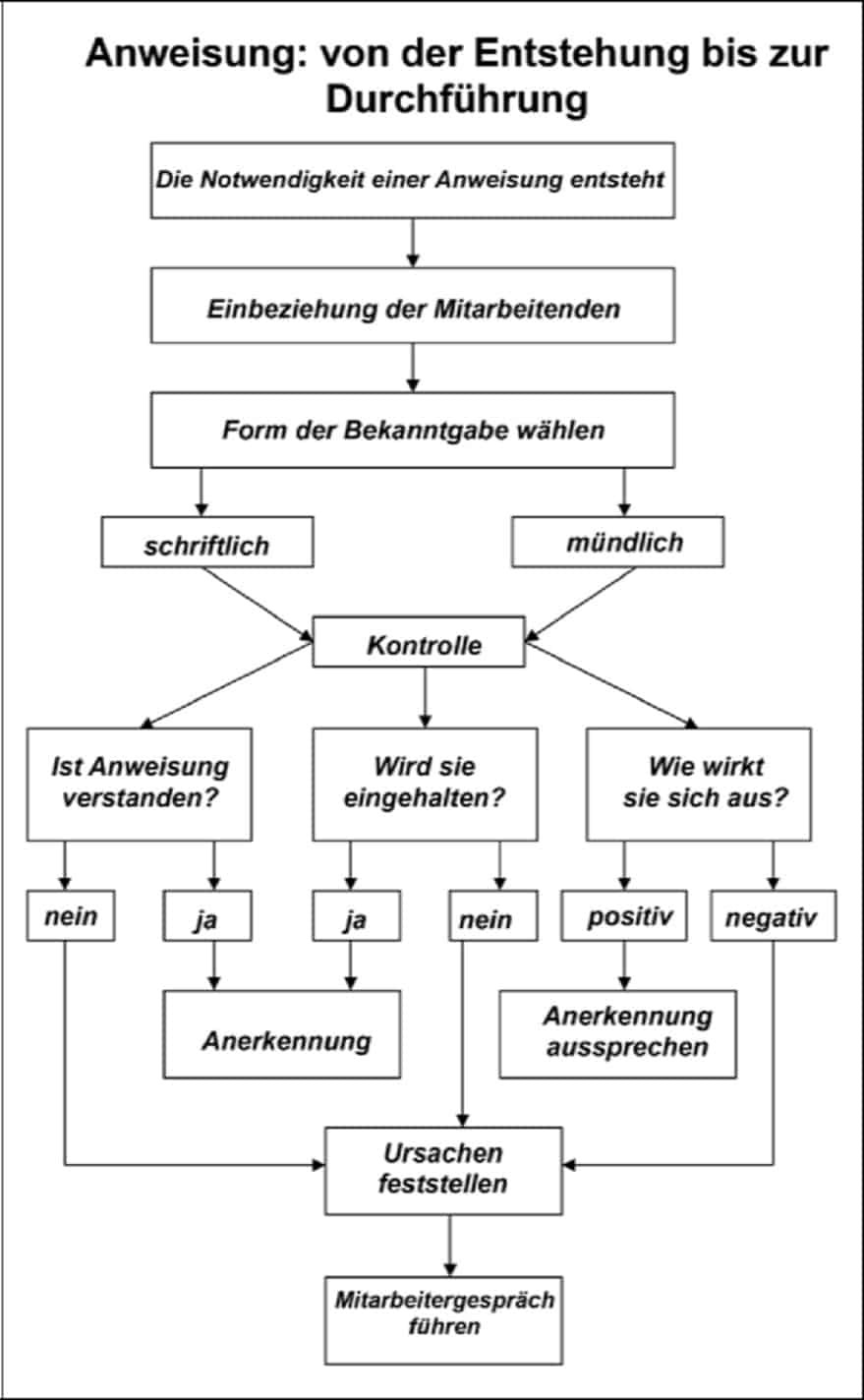carry out instructions
The term "instruction" is usually seen negatively by staff. It stands for "order", "command", "regulation", and depending on the wording, the employee recognises the raised forefinger of his boss or superior and feels restricted in his freedom. Instructions restrict the independent thinking of the employee, he feels like a recipient of orders. In the case of new legal provisions and regulations that must be complied with, employees are more understanding than in the case of so-called arbitrary instructions, which usually only benefit the company. In order to ensure that directives are complied with, it is important to integrate the team and to convince everyone of the advantages and benefits in order to avoid scepticism and resistance.

Fewer rules and specifications bring more commitment and motivation in the team. In communication there is a gradation with clear differences. The lower level is the boss's wish as to how a job should be done. With his "wish" he shows the employee how he imagines the work to be done and leaves it up to the person concerned to move freely within tolerance limits. Limit values are to be kept however. Typical of conversations is the formulation "I would like ...", "I imagine ...", "I wish ...". There is still room for manoeuvre in the completion of the work, only the result of the work and the final date are specified. An instruction does not leave room for manoeuvre. It is about fixed criteria, which must be kept, otherwise there can be consequences. A violation of this is clear misconduct. Typical phrases are: "I order you to ...", "I must ask you to ...", "You must pay attention to ...". Instructions are also based on regulations that must be observed by law.
The "worst case" method describes the worst case scenario that occurs if the regulation is not followed ("Imagine the effects/disadvantages that can occur if the regulation is not followed"). The negative consequences of non-compliance with an instruction give rise to fears among employees. Compliance therefore becomes compulsory. The boss should start with the "best case", i.e. the advantages of compliance.
"Guard rails" instead of rigid rules
In many companies, there is not too little, but too much regulation. This restricts the independent thinking of employees, and most of them feel like they are receiving orders. That is why there is the term "guard rails", within which everyone can move when carrying out their work. Guard rails can be compared to road traffic. If one touches a crash barrier, usually due to a driving error, damage occurs. They show the way, but still leave room for manoeuvre; everyone can move freely within the crash barriers, but must comply with limit values. It's like in road traffic: In contrast to fixed rules, there are no rigid specifications for crash barriers that must be adhered to at all costs, so the team assumes a certain amount of responsibility for itself.
Instructions must stand and not be withdrawn or changed again in a short time. Rework is not exactly beneficial. Example: A changed working or break time. Spontaneous decisions are risky, often decisions have to mature before they are implemented. Alternatively, an instruction can be explicitly designated as a "test" for a certain period of time after consultation with the staff (trial run).
"Any exception to a rule should be defined as an individual case."
There should be no exceptions for compliance, it applies to everyone, without exception, including the boss himself. The more the team is involved in a directive, the better. Those who can participate feel involved. Of course, you can't please everyone, some are always against it and have their reasons. With every instruction, the question arises among the employees as to what benefit it has. The more an instruction takes into account the interests of the employees, the better. If changes come suddenly and unexpectedly, the boss must expect resistance.
infringement of an order
If only one person violates an instruction, this usually has an impact on colleagues. Then the so-called "avalanche effect" arises. If colleagues notice that someone is violating instructions, there is a risk that they will also not comply with the instruction and wait to see if they are caught and spoken to. Even small violations of an instruction cause major costs and can disrupt logistics. Timely notification that a deadline cannot be met should be part of the employee's duty, the sooner the better. If the information is given in good time, it may be possible to find an alternative solution for the deadline work.
The supervisor is not only responsible for compliance, but must also command respect and enforce instructions. Staff must therefore comply with rules without exception. Every exception to a rule should be defined as an individual case and, in the context of equal treatment of all, should rarely be acknowledged. If the superior gives way in an individual case, this undermines his authority. Non-compliance with an instruction must be followed by a critical discussion with the person concerned.
If your criticism meeting is unsuccessful, then a written warning is necessary. The reference to steps under labour law is of great importance when issuing a warning. In terms of labour law, the superior, as the management's representative, has the authority to instruct and control within his area of competence. The employee has a "duty of obedience" towards him.
The 4-B strategy for regulations:
1.) Make known
Instructions that are given suddenly and unprepared are met with scepticism. Therefore: First discuss and debate, then introduce officially.
2.) Describe
Formulations that are imprecise raise questions and lead to confusion. Therefore: give clear and unambiguous information (who does what, when, how and where?), without different interpretations.
3.) Justify
Regulations that seem arbitrary are usually rejected. Therefore: Point out the necessity and advantages and explain why they are necessary.
4.) Participate
See regulations, in the planning and implementation of which the employees are involved, as their own business. Therefore: opinions, hints
It is essential that we allow and take into account any suggestions and proposals.









